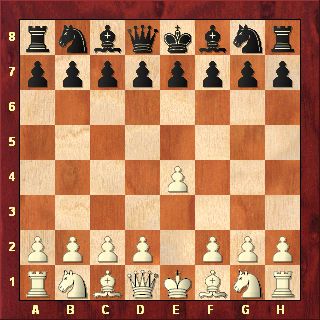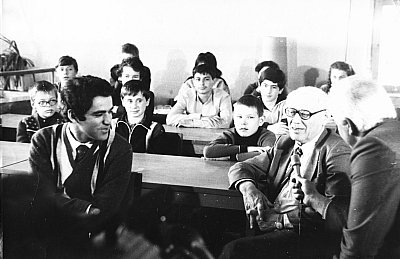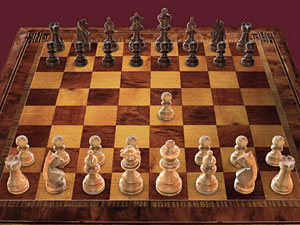The following problem is the first that appeared in our puzzle section – and the most famous. It was published when GM Wei Yi, who knocked out Alexei Shirov in the World Cup yesterday, was six months old (so it is reasonable to assume he missed it). People are still sending letters asking for the solution, twelve years later – even when the ChessBase puzzle section went off-line earlier this year they were finding this one in the WayBack machine. It is the first we are going to republish in our new format, and it will be followed in regular intervals by cherries we will pick out of the original section. For older readers it will hopefully bring on nostalgic memories; younger readers will learn for the first time what we have been up to over the years.
ChessBase Christmas Puzzle 1999
By Frederic Friedel
A game begins with 1.e4 and ends in the fifth move with knight takes rook mate

This is the starting position. All you have to do is enter some legal chess moves, so that the game ends on move five with the stipulated knight takes rook mate. Easy enough, don't you think? Maybe not. When British grandmaster and author John Nunn gave me this problem originally, he sealed the answer in an envelope and asked me to return it unopened, with the solution written on the back. Together with Ken Thompson, the famous computer scientist, I spent many hours trying to solve the problem (and Ken spent at least an hour trying to read the contents of the envelope over a bright light). In the end we tore the thing open and admitted humiliating defeat.
There is a nice story about this problem. In 1986, during the turmoils after Kasparov had won the world championship and was forced to face an immediate rematch, both he and Karpov went to Lucerne to meet with FIDE President Campomanes. I was with them and we had a long car journey together from Zurich to Luzerne. To entertain them I gave the two top players in the world John's puzzle. It kept them busy during the ride and for the next couple of days in the hotel. They couldn't solve it.
Before we parted I did the Nunn thing on Garry: I sealed the answer in a hotel envelope and told him to return it unopened with the solution. I didn't hear from him for many months. Then one day I came home and found a number of messages with a phone number where I should call Kasparov urgently. I did so and found him in a distraught state. "You are a dead man, Fred," he said, "you have put me in a very embarrassing situation." Turns out he was running a session of his chess school, together with Mikhail Botvinnik, and he had given the problem to his students. When they couldn't solve it and asked him for the answer he had told them how important it was to persevere. They should not give up but try for another day. Meanwhile the hunt was on for the envelope, which unfortunately could not be located. When I told him the solution on the phone I could hear Botvinnik gasp in the background. And Garry, who like every one else in the chess school, was convinced I had stated the problem incorrectly, couldn't believe that he and his students had missed it.
Another little story? I was telling the above to Vishy Anand and Vlady Kramnik some time ago in a little restaurant, in Wijk aan Zee. They listened bemused, thinking that I was probably adding a lot of journalistic dressing to the whole narrative. But then suddenly a grandmaster sitting at the adjacent table turned to us and said, "Are you talking about the problem which Kasparov gave his students back in 1986? Well, I was one of the students!" The grandmaster was Boris Alterman, now grown up and one of the seconds that has helped Garry in some of his matches.

Boris sent us the above picture that was taken during the 1986 Botvinnik School session described above. It shows Garry Kasparov and Mikhail Botvinnik (being interviewed), and the youthful Boris Alterman sitting in the middle of the picture in the second row of students.
Reactions
I presented the 1999 Christmas puzzle in an article in ChessBase Magazine 73 and offered a special prize – a book signed by some of the world's top players, confirming that the winner is the greatest. The article was posted on a number of Internet chess forums, where people immediately launched concerted efforts to solve the puzzle.
On Christmas day 1999 I posted the article on my favourite site, the geek watering-hole Slashdot (“News for Nerds”), which is aimed at people who are interested in science, technology, computers, programming and weird stuff in general. At the time they had 120,000 unique visitors and about one million page views per day. Just a few hours after the slashdot posting all hell broke lose. A lot of emails had been coming in from CBM subscribers and the chess forum crowd, but the ones from Slashdot were like a tsunami and swept everything else away. I received a total of well over a thousand messages, and even many months later, after the solution had been published, they kept coming. As one visitor, Ken Boucher, wrote: 'Frederic, all of Slashdot went nuts thanks to you. When your puzzle was posted there I and many others lost all productivity until someone managed to solve it. Brilliant sir, brilliant. Thanks for a reminder of why I used to play chess."
Initially, on Christmas day and immediately thereafter, only a very small number of correct solutions were submitted to me by email. One interesting phenomenon was that a numerical majority of these came from East German grandmasters. Apparently the puzzle was known in the chess schools there. And I got correct answers from a couple of Russian players, like the then US champion Anjelina Belakovskaia, who wrote: “Are you joking or what? I have the puzzle in a book I wrote in 1990 and give it to my students from time to time. It is one of the tricks I learned in the 'School for Russian Stars' by A. Panchenko. Don't forget I am from Soviet Chess School!”
But an overwhelming number of messages had wrong solutions. The most common error was that the contestants would overlook a check, and the most common line (by far) was 1.e4 Nc6 2.a4 Nb4 3.Ra3 Nxc2+ 4.Rd3 (??) Nb4 5.Ne2 Nxd3#. Of course 4.Rd3 is illegal since it ignores a check.
Another very common solution involved interpreting the puzzle in a way that one could use an extra ply. “I'm convinced this is a matter of semantics," one reader wrote, "and that the 'fifth move' refers to the fifth move after 1.e4, which means the game really ends on the sixth move. Then the solution is 1.e4 g5 2.Qh5 h6 3.Nf3 Nc6 4.Nxg5 b6 5.Nxf7 a5 6.Nxh8#”. Another common six-mover was 1.e4 f6 2.Nf3 g5 3.Ne5 a6 4.Ng6 a5 5.Qh5 a4 6.Nxh8#. No, dear readers, the mate happens on move five. A lot of readers carefully parsed the puzzle, looking for linguistic tricks, others provided imaginative and convincing proofs that a solution could not exist.
The winner
Picking a winner from all the correct solutions I received was not an easy task. One of the problems was that someone posted the solution on the Internet, and immediately after this had occurred I started getting a dozen or so correct answers per day, up from one every three days before then. So I picked David Bellows, who very early on gave me a vivid and plausible description of his thought process. “It was an amazingly difficult and enjoyable problem, and I spent a total of eight hours working on it (divided into two days)”, he wrote. As a prize he received a beautiful book, “Chess Highlights of the 20th Century” (by Graham Burgess, Gambit Publications 1999). On the first page there was a commemoration, certifying that David Bellow is the greatest. It was signed by Garry Kasparov, Vishy Anand, Vladimir Kramnik, Alexander Morosevich, Peter Leko, Michael Adams, Judit Polgar and a number of other players (from the super-tournament in Wijk aan Zee). David is a webmastr and music composer living in Atlanta, Georgia.

The solution
Ah, naturally I'm not going to reveal it here. There will be many new visitors who do not know the problem, and it must not be spoiled for them. If you have unbearable difficulty finding the solution then write to us in a few months. But don't expect to receive the solution without a fight!


























